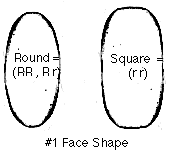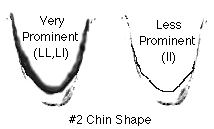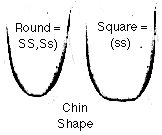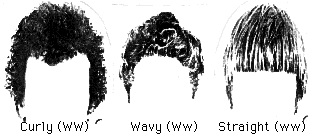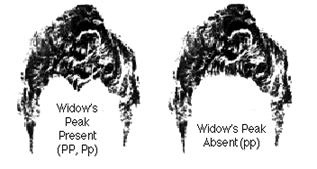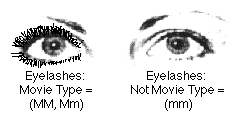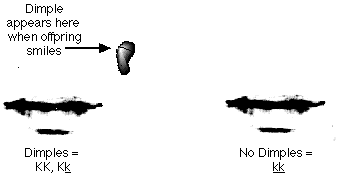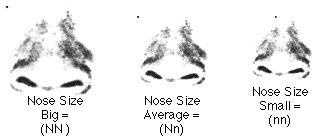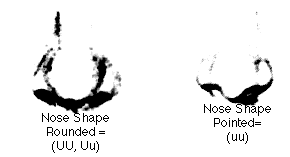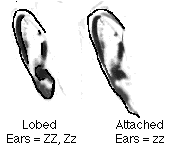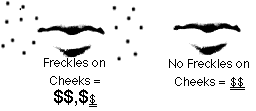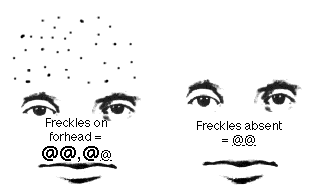Making A Face - A Genetic Simulation
Converting Genotype Into
Phenotype by Simulating Gametogenesis, Fertilization
and Embryogenesis

Congratulations, you are going to have a baby!..... Well, you are actually going to simulate having a baby.
After this simulation, you should be able to answer the following questions:
- How many chromosome pairs does each human parent have?
- How many chromosomes does each parent "donate" to the next generation?
- Are some genes and gene characteristics expressed over others.... are dominant and recessive genes responsible for how a baby looks?
- What is the difference between Genotype and Phenotype?
- Do some traits require more than one gene to be fully expressed?
- What are sex-linked traits?
- How is there so much variation in the way children look even if they come from the same parents?
- What is epistasis?
- What is polygenic inheritance?
Why siblings are very different both in genotype and phenotype is the question we want to address in this simulation. This activity should help you answer that question and stimulate other questions as well.
Directions continued from page one.
You have been given a pink set of chromosomes if you are going to represent the wife, and a blue set of chromosomes if you are going to represent the husband. We are asking the question... What would your baby look like if both you and your classmate (who will simulate your spouse) have one dominant gene and one recessive gene for each of the facial features illustrated on the following pages? This, of course, is not the way it really is, but this is a simulation. Each of you will be heterozygous for each trait. To determine the facial appearance of your child, you and your spouse will drop your 23 pair of chromosomes to the floor to simulate gametogenesis (sex cell formation). This "dropping your chromosomes" will determine which one of the pair of chromosomes will enter the successful sex cell. Each parent, mom and dad, donate one and only one of each of their 23 pair of chromosomes. Therefore they both donate 23 chromosomes. Since genes ride in the DNA of the chromosomes, each child will end up with a pair of genes for each trait, one from the dad and one from the mom.
After you drop your own chromosomes and line them up according to size, then you will "mate" with your partner by pushing the chromosomes one at a time toward one another until they are side by side. This represents the establishment of pairs of chromosomes. When you are done you should have twenty three pairs of chromosomes again. The mathematics of sex is..... one of each pair from the mother.....Plus.... one of each pair from the father equals a pair of each kind for the baby! You essentially will supply one gene and your spouse will supply one gene for each characteristic. The resulting two genes that are paired up will produce the genotype. Record the genetic contributions from each parent on the chart provided. Translate the genetic information into the phenotypic information, type of protein (what will your baby look like). You and your spouse will produce one child only. Name the baby. Each of you go home and make a birth announcement which describes in rich and loving detail your wonderful offspring. After this is done, then you will each produce an excellent final draft drawing of your baby 15 years later when he or she is in high school! Do not place the child's name on the front of your paper....only on the back. We want to see if we can match you and your mate's drawings of your child. Don't collaborate with your mate on either one of these assignments.
Making a Baby!
Marriage Ceremony. There will
be a short marriage ceremony. The long-term /
lifetime commitment of a husband and
wife bond is the preferred way to raise children. Place the married names of
the parents on the data table that is provided to you. Get away in a secluded
spot and get ready to make some sex cells.
Gametogenesis. Hold the chromosomes high in the air above your head.
Drop them one at a time to the floor. If they don't twirl then drop them again.
When they have all dropped to the floor carefully pick them up without turning
them over and find a lab table where you can face each other, then organize
them according to size. Your teacher will demonstrate how they should line up.
Equal sizes should be across from each other as you face your partner. The sex
chromosomes should be organized away from the 22 autosomal
chromosomes. Keep in mind that you begin this exercise with the chromosome pair
above your head, they twirl down to the floor and finally land.... only one
of the pair face up.... this upward facing one of the pair represents the
chromosome that ended up in the successful gamete that you have just produced.
Yes, those 23 chromosomes that are all neatly lined up represent the contents
your sperm or egg. Since you have your sperm and egg produced, it is time to
mate!
Mating / Fertilization. Gently push the like-sized chromosomes toward each other at point halfway between you, pair them up according to size and number. This represents the moment when a new human potential is reached. A totally unique human is conceived!
Determination of child's sex. After conception, parents are always interested in determining the sex of their child. In this case the "husband" has pushed either an "X" chromosome or a "y" chromosome toward the middle (which ever dropped facing up) and matched it with the "wife's "X" chromosome. If an "X", then you have a beautiful little girl, if a "y", then a beautiful little boy! Give your child a name and record the name on your data sheet.
Determination of various genotypes. Do the same with all of the chromosomes. Carefully read the genes on the chromosomes and circle the resulting genotypes and phenotypes on the chart that is provided to you.
Making Birth Announcement. Finally, after all of the phenotypes have been determined you need to go home and make a birth announcement which will describe how proud you are of your offspring, and what he or she looks like. Use all of the traits / phenotypes that you have in the data table.
Draw the baby. Time passes, you get older, your baby is growing up! What does your baby look like now that he or she is a teenager? Make a full page drawing of your teenager's face using your best drawing ability. Color is necessary; some of the genes produce pigment!
How to cut the chromosome models out properly.
|
Step #1 Cut out each pair of chromosomes on the solid line that surrounds each pair. |
|
Step #2 Fold along the dotted line between the pair of chromosomes. |
|
|
Step #3 Glue/tape the folded pair together, press until they are perfectly flat. Watch for undried glue squeezing out from between the chromosomes; they may stick with other chromosomes! |
|
Step #4 Bring your chromosomes to school in an envelope stored in one of your books.... keep your paired chromosomes flat! |
|
Cut these pairs of chromosomes out using these instructions.

|
Characteristic |
Geno -> Pheno |
Geno -> Pheno |
Geno -> Pheno |
Geno -> Pheno |
Geno -> Pheno |
Geno -> Pheno |
Geno -> Pheno |
Geno -> Pheno |
Geno -> Pheno |
||||||||||||||||||||||||||||||||||||||||||||||||||||||||||||||||||||||||||||||||||||||||||||||||||||||||||||||||||||||||||||||||||||||||||||||||||||||||||||||||||||||||||||||||||||||||||||||||||||||||||||||||||||||
|
Sex |
Female |
Male |
|
|
|
|
|
|
|
||||||||||||||||||||||||||||||||||||||||||||||||||||||||||||||||||||||||||||||||||||||||||||||||||||||||||||||||||||||||||||||||||||||||||||||||||||||||||||||||||||||||||||||||||||||||||||||||||||||||||||||||||||||
|
Sex Chromosomes |
XX
|
XY
|
|
Mother's Name Kid's Name |
|
|
Father's Name |
|
|
||||||||||||||||||||||||||||||||||||||||||||||||||||||||||||||||||||||||||||||||||||||||||||||||||||||||||||||||||||||||||||||||||||||||||||||||||||||||||||||||||||||||||||||||||||||||||||||||||||||||||||||||||||||
|
|
|
|
|
|
|
|
|
|
|
||||||||||||||||||||||||||||||||||||||||||||||||||||||||||||||||||||||||||||||||||||||||||||||||||||||||||||||||||||||||||||||||||||||||||||||||||||||||||||||||||||||||||||||||||||||||||||||||||||||||||||||||||||||
|
Face Shape |
Round |
Round |
Square |
|
|
|
|
|
|
||||||||||||||||||||||||||||||||||||||||||||||||||||||||||||||||||||||||||||||||||||||||||||||||||||||||||||||||||||||||||||||||||||||||||||||||||||||||||||||||||||||||||||||||||||||||||||||||||||||||||||||||||||||
|
|
RR |
Rr |
rr |
|
|
|
|
|
|
||||||||||||||||||||||||||||||||||||||||||||||||||||||||||||||||||||||||||||||||||||||||||||||||||||||||||||||||||||||||||||||||||||||||||||||||||||||||||||||||||||||||||||||||||||||||||||||||||||||||||||||||||||||
|
|
|
|
|
|
|
|
|
|
|
||||||||||||||||||||||||||||||||||||||||||||||||||||||||||||||||||||||||||||||||||||||||||||||||||||||||||||||||||||||||||||||||||||||||||||||||||||||||||||||||||||||||||||||||||||||||||||||||||||||||||||||||||||||
|
Chin Shape |
J. Leno |
J. Leno |
Not Leno |
|
|
|
|
|
|
||||||||||||||||||||||||||||||||||||||||||||||||||||||||||||||||||||||||||||||||||||||||||||||||||||||||||||||||||||||||||||||||||||||||||||||||||||||||||||||||||||||||||||||||||||||||||||||||||||||||||||||||||||||
|
|
LL |
Ll |
ll |
|
|
|
|
|
|
||||||||||||||||||||||||||||||||||||||||||||||||||||||||||||||||||||||||||||||||||||||||||||||||||||||||||||||||||||||||||||||||||||||||||||||||||||||||||||||||||||||||||||||||||||||||||||||||||||||||||||||||||||||
|
|
|
|
|
|
|
|
|
|
|
||||||||||||||||||||||||||||||||||||||||||||||||||||||||||||||||||||||||||||||||||||||||||||||||||||||||||||||||||||||||||||||||||||||||||||||||||||||||||||||||||||||||||||||||||||||||||||||||||||||||||||||||||||||
|
Chin Shape |
Round |
Round |
Square |
|
|
|
|
|
|
||||||||||||||||||||||||||||||||||||||||||||||||||||||||||||||||||||||||||||||||||||||||||||||||||||||||||||||||||||||||||||||||||||||||||||||||||||||||||||||||||||||||||||||||||||||||||||||||||||||||||||||||||||||
|
If LL or Ll only |
SS |
Ss |
ss |
|
|
|
|
|
|
||||||||||||||||||||||||||||||||||||||||||||||||||||||||||||||||||||||||||||||||||||||||||||||||||||||||||||||||||||||||||||||||||||||||||||||||||||||||||||||||||||||||||||||||||||||||||||||||||||||||||||||||||||||
|
|
|
|
|
|
|
|
|
|
|
||||||||||||||||||||||||||||||||||||||||||||||||||||||||||||||||||||||||||||||||||||||||||||||||||||||||||||||||||||||||||||||||||||||||||||||||||||||||||||||||||||||||||||||||||||||||||||||||||||||||||||||||||||||
|
Cleft Chin |
Cleft |
Cleft |
No Cleft |
|
|
|
|
|
|
||||||||||||||||||||||||||||||||||||||||||||||||||||||||||||||||||||||||||||||||||||||||||||||||||||||||||||||||||||||||||||||||||||||||||||||||||||||||||||||||||||||||||||||||||||||||||||||||||||||||||||||||||||||
|
If LL or Ll only |
CC |
Cc |
cc |
|
|
|
|
|
|
||||||||||||||||||||||||||||||||||||||||||||||||||||||||||||||||||||||||||||||||||||||||||||||||||||||||||||||||||||||||||||||||||||||||||||||||||||||||||||||||||||||||||||||||||||||||||||||||||||||||||||||||||||||
|
|
|
|
|
|
|
|
|
|
|
||||||||||||||||||||||||||||||||||||||||||||||||||||||||||||||||||||||||||||||||||||||||||||||||||||||||||||||||||||||||||||||||||||||||||||||||||||||||||||||||||||||||||||||||||||||||||||||||||||||||||||||||||||||
|
Skin Color |
Very Very Dark Brown |
Very Dark Brown |
Dark Brown |
Medium Brown |
Light Brown |
Light Light Brown |
Very Very Light Brown |
|
|
||||||||||||||||||||||||||||||||||||||||||||||||||||||||||||||||||||||||||||||||||||||||||||||||||||||||||||||||||||||||||||||||||||||||||||||||||||||||||||||||||||||||||||||||||||||||||||||||||||||||||||||||||||||
|
Polygenic |
AAAAAA |
AAAAA / a |
AAAA / aa |
AAA / aaa |
AA / aaaa |
A / aaaaa |
aaaaaa |
|
|
||||||||||||||||||||||||||||||||||||||||||||||||||||||||||||||||||||||||||||||||||||||||||||||||||||||||||||||||||||||||||||||||||||||||||||||||||||||||||||||||||||||||||||||||||||||||||||||||||||||||||||||||||||||
|
|
|
|
|
|
|
|
|
|
|
||||||||||||||||||||||||||||||||||||||||||||||||||||||||||||||||||||||||||||||||||||||||||||||||||||||||||||||||||||||||||||||||||||||||||||||||||||||||||||||||||||||||||||||||||||||||||||||||||||||||||||||||||||||
|
Hair Color |
Black |
Very Dark Brown |
Dark Brown |
Brown |
Light Brown |
Honey Blond |
Blond |
Very Light Blond |
VERY light! Platinum |
||||||||||||||||||||||||||||||||||||||||||||||||||||||||||||||||||||||||||||||||||||||||||||||||||||||||||||||||||||||||||||||||||||||||||||||||||||||||||||||||||||||||||||||||||||||||||||||||||||||||||||||||||||||
|
Polygenic |
HHHHHHHH |
HHHHHHH / h |
HHHHHH / hh |
HHHHH / hhh |
HHHH / hhhh |
HHH / hhhhh |
HH / hhhhhh |
H / hhhhhhh |
hhhhhhhh |
||||||||||||||||||||||||||||||||||||||||||||||||||||||||||||||||||||||||||||||||||||||||||||||||||||||||||||||||||||||||||||||||||||||||||||||||||||||||||||||||||||||||||||||||||||||||||||||||||||||||||||||||||||||
|
|
|
|
|
|
|
|
|
|
|
||||||||||||||||||||||||||||||||||||||||||||||||||||||||||||||||||||||||||||||||||||||||||||||||||||||||||||||||||||||||||||||||||||||||||||||||||||||||||||||||||||||||||||||||||||||||||||||||||||||||||||||||||||||
|
Eye Color |
Dark Brown |
Brown |
Brown |
Brown |
Dark Blue |
Dark Blue |
Light Blue |
Light Blue |
Pale Blue |
||||||||||||||||||||||||||||||||||||||||||||||||||||||||||||||||||||||||||||||||||||||||||||||||||||||||||||||||||||||||||||||||||||||||||||||||||||||||||||||||||||||||||||||||||||||||||||||||||||||||||||||||||||||
|
|
FFBB |
FFBb |
FFbb |
FfBB |
FfBb |
Ffbb |
ffBB |
ffBb |
ffbb |
||||||||||||||||||||||||||||||||||||||||||||||||||||||||||||||||||||||||||||||||||||||||||||||||||||||||||||||||||||||||||||||||||||||||||||||||||||||||||||||||||||||||||||||||||||||||||||||||||||||||||||||||||||||
|
|
|
|
|
|
|
|
|
|
|
||||||||||||||||||||||||||||||||||||||||||||||||||||||||||||||||||||||||||||||||||||||||||||||||||||||||||||||||||||||||||||||||||||||||||||||||||||||||||||||||||||||||||||||||||||||||||||||||||||||||||||||||||||||
|
|
|
|||||||||||||||||||||||||||||||||||||||||||||||||||||||||||||||||||||||||||||||||||||||||||||||||||||||||||||||||||||||||||||||||||||||||||||||||||||||||||||||||||||||||||||||||||||||||||||||||||||||||||||||||||||||||||||
Genotype to Phenotype
Translation Booklet

The contents of this booklet
will help you determine
what your baby will look like.
|
If your dropping of the genes resulted in two "XX" chromosomes turning face up, then you are the very lucky parents of a little girl. The Mom contributed one "X" and the Dad the other "X". |
Its a Girl! |
||||
|
If your dropping of the genes resulted in an "Xy" combination of chromosomes turning face up, then you are the very lucky parents of a little boy. The Mom contributed one "X" and the Dad the "Y" chromosome.
|
Its a Boy!
|
||||
|
|
|
|
|||
|
|
||||
|
|
|
||||
|
|
||||
|
|
Chromosome #3 contains the "S" gene. This gene controls the shape of the chin, round or square. These genes are activated only if the dominant "L" on chromosome #2 is present. Place your baby's genotype for chin shape in the data table. The control of one set of genes by another is called epistasis. |
|
|
|
Chromosome #5 carries the "C" gene. The "C" gene controls the development of the cleft chin phenotype. Remember these "C" genes are activated only if the dominant "L" on chromosome #2 is present. Place your baby's genotype for chin shape in the data table. The control of one set of genes by another is called epistasis. |
|
Skin color is determined by three sets of genes on chromosomes #'s 1, 2,and4. The dominant genetic code, gene "A" translates into a protein called melanin. This dark pigment is like a natural UV blocker. The greater the number of dominant genes one has, the greater the amount of melanin, the darker the skin, and the more UV protection a person has. These genes have been selected-for near the Earth's equator where the intense UV photons can cause a great deal of damage to lighter skin. Count up the number of dominant and recessive genes and place your baby's genotype for skin color in the data table. |
|
|
|
The hair color gene, like skin color, is polygenic. The same genetic code is found on chromosome #'s 3, 4, 10 and 18. This code translates into pigment which is incorporated into the hair as it is growing. The greater the number of dominant alleles, the darker the hair. Hair color varies from black to white. Count up the number of dominant and recessive genes and place your baby's genotype for hair color in the data table.
|
|
|
|
Chromosomes #'s 11 and 12 contain Eye Color Genes: Darker eyes are produced in the presence of more active alleles. In this situation, the Capital letters (F or B) represent alleles which are active in depositing dark pigment. Lower case letters (f or b) represent alleles which deposit little pigment. To determine the color of the eyes, assume there are two gene pairs involved, one of which codes for depositing pigment in the front of the iris, and the other codes for depositing pigment in the back of the iris. Determine the genotype of the first pair (FF,Ff,ff). and the the second (BB,Bb,bb). If your genotype is in the first column then check your eye color in the second column. |
Place your baby's genotype for eye color in the data table. |
|
|
Red Hair: Red hair is another gene for
hair color present on a different chromosome.It
blends its effect with other hair colors. Redness of the hair seems to be
caused by a single gene pair with two alleles, red (G) or no red (g), and
displays incomplete dominance. Thus, if a person has two genes for red (GG),
the hair will be a more intense red than if they have a single gene (Gg). If a person has no genes for red (gg), then the hair does not show as red at all. Red hair
is complicated by the fact that dark pigment, controlled by the many hair
color genes, may mask or hide the red color. The darker the brown, the less
the red shows through, although more shows with (GG) than with (Gg). As the hair becomes lighter in color, more red shows
through. If your child is blond as evidenced by 3 Capitals or less above and
(GG) lands facing up, then your child will probably have flaming red hair.
|
|
|
|
|
||
|
||
|
|
||
|
|
|
||
|
||
|
|
||
|
|
|
||
|
||
|
|
||
|
|
|
||
|
||
|
|
||
|
|
|
||
|
||
|
|
|
|
|







